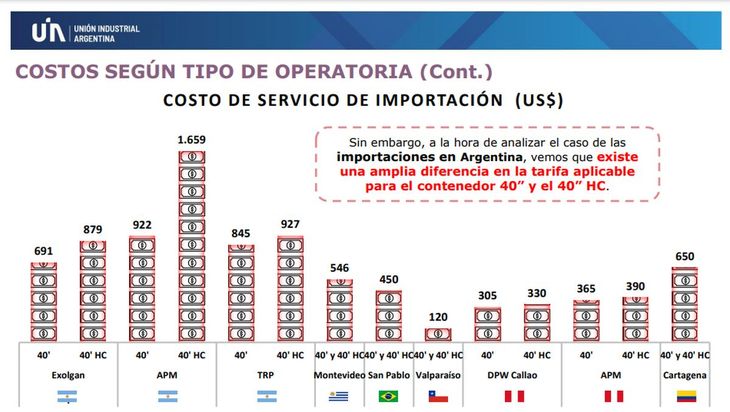Entrepreneurs Industrialists expressed their concern about the high costs of operations in Argentine port terminals and they stressed that they function as a “export barrier”, while they warned that the situation was deteriorated in recent months.
According to a survey carried out by the chambers and companies that make up the Argentine Industrial Union (UIA), the country’s ports They have the most expensive operating costs in the region, above Brazil, Chile, Colombia, Peru and Uruguay.
Concern about logistics costs in Argentine ports
In this regard, the institution expressed its concern and assured that “port terminals have taken advantage of the opportunity to renegotiate contracts under which the maximum price at which they can establish their rates for services was eliminated through Decree 299/23.” This process resulted in an increase of more than 25% in the cost in dollars.
At the same time, the call for bids to increase the toll rate of the Trunk Waterway (VNT) by 40% has an impact. and 60%, with the objective of settling an outstanding debt accumulated with the company that carries out the dredging service of the same.
“From the entity we have expressed in the different work table meetings our disagreement with this increase, as well as the need to find another way to renegotiate the debt or generate a redistribution of resources in the entity to comply with this obligation, in such a way that it is not the burden that ends up paying the cost of previous poor management, at the expense of the competitiveness of national production,” said the UIA.
The industrialists said that the main actor on whom the payment of said debt will fall will be the productive sector, given that at the same time a 20% rate bonus has been applied to cruise ships.
According to the survey carried out by the UIA, in Argentina, Moving a 40-foot container is 2% more expensive, with a peak of 24%, for exports, while the increase is 51%, with a peak of 70%, for imports.
1.jpg
Meanwhile, moving a 40-foot High Cube container in Argentina is more expensive than the average for the region: 1% with a peak of 22% for exports, and 70% with a peak of 151% for imports.
Industrial proposals for Argentine ports
As a solution, The UIA proposes to make transparent the cost of port security that is currently charged to the total cargo by the port and to extend the opening hours of customs to reduce the need to resort to extraordinary services.
Also eliminate the extra cost for services to High Cube (HC) containers, eliminate the truck parking charge when the delay is due to a terminal problem, define that the “removal” does not apply to internal cargo and Implement the Bill of Landing electronic.
In the specific case of the terminals of the Port of Buenos Aires, which have a concession that expired on August 31, 2023, and that was extended from September 2023 for 3 years without maximum rates, They ask to establish that the modification of the rates must be against the presentation of the cost structures and the justification of the increases and to retrograde the AGP rate to the amounts of November 2022, given that they are sums in dollars that it receives for the use of spaces, docks or structures already amortized.
1.jpg

Finally, the UIA promotes, for the Trunk Waterway, modifying the current tariff schedule applied by AGP by including the Port of Buenos Aires and Dock Sud in the first section; apply an appropriate tariff schedule for the Santa Fe-Confluencia section; carry out environmental impact studies to deepen the VNT to 42 feet; and, finally, Eliminate the “Ship Watchdog” (which today is replaced with a management and safety code).
In a letter sent to the head of the General Administration of Ports SE, Gastón Benevuto, the institution stated that these excessive increases in dollars occur in “a context where the logistical difficulties of our production in recent years have been growing, and without taking into account the additional effects of the economic situation, which is negatively affecting industrial activity and in particular SMEs.”
They also considered that “the drop in sales and production makes it significantly difficult to absorb these costs in their operating volumes, significantly affecting their competitiveness and their export possibilities.”
Source: Ambito
David William is a talented author who has made a name for himself in the world of writing. He is a professional author who writes on a wide range of topics, from general interest to opinion news. David is currently working as a writer at 24 hours worlds where he brings his unique perspective and in-depth research to his articles, making them both informative and engaging.




